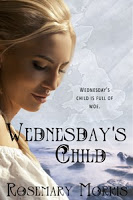Today, we welcome Rosemary Morris to the RNA Blog, with some tips for new writers.

Since the first of my nine Romantic Historical Fact Fiction Novels was published by BooksWeLove Inc. a frequent question is: “Where do you find ideas?” I answer: When I read historical non-fiction something activates, my imagination. For example, I read about James II, whose daughter Mary and her husband William of Orange, usurped his throne. After their deaths, his younger daughter, Anne, became Queen. When the peers of the realm were required to swear an oath of allegiance to her, some refused to break their pledge to James II. Even if they disliked the man, his politics and his religion, they believed they were honour bound not to break faith with him during his lifetime.
I closed the book and asked myself what future two children, whose fathers were Jacobites, would have in my novel, Tangled Love.
Before I begin writing a story I choose Christian names and surnames appropriate for my main characters’ era. After hours of consulting dictionaries of names, I chose Gervaise Seymour and Richelda Shaw for my hero and heroine in Tangled Love.
Who were Gervaise and Richelda? To find out I filled in detailed character profiles that brought them to life. By the time I had described: their appearance, eccentricities, education, family, bad habits, preferences e.g. perfume, music etc., and religion, I knew them almost as well as I know my family. Although a lot of information did not surface in the novel it saved Gervaise and Richelda from being stereotypes.
While doing housework and other mundane tasks I spend a lot of time deciding what makes my major and minor characters tick. Duty, Fear, Greed, Hatred, Jealousy, Loneliness, Love, Revenge or Vanity?
Another step is making notes about the economics, politics, social history, etiquette etc., as well as the settings that I will use as a background for my fact fiction.
Some novelists plot every chapter, before they begin writing. I did this, after reading a How to Write Book, for Sunday’s Child, Heroines Born on Different Days of the week, Book One.
In Sunday’s Child the heroine’s father and brothers died during the long war against the French, and the hero suffers post-traumatic stress syndrome after serving in the army, (a condition not recognised at that time). Although I wrote a detailed plot plan I struggled when I tried to apply it. After I wrote half of the book, I and my characters were in straight-jackets. The story seemed contrived, so I tore up the plot plan. When I wrote the draft of the next version, I allowed my protagonists to surprise me as they experienced happiness and distress, conflict and obstacles etc.
Since then, although I have a plot, a theme and characters in mind, I have never planned a novel in detail. However, if a murder takes place in a future novel I might want to work out the details in advance.
There is no right or wrong way to tackle fiction, what works for one author may not work for another. I am merely sharing my first steps.
I think all of us have read novels that promise more than they deliver, and have either abandoned them or been disappointed at the end. Perhaps this is because the author plunged into the book without adequate preparation or the inability to diverge from a rigid outline.
Whichever method we choose and whichever genre we write in, we need to be versatile, bring our characters to life and show the reader their world, historical or modern. This coupled with a ‘page-turning’ story with lots of twists and turns should earn excellent reviews, and satisfied readers, who look forward to reading our new releases.
Thanks so much for your post, Rosemary. We will be posting some more Hints and Tips for new writers next year on the blog.
*****
Rosemary’s latest book,
Wednesday’s Child, Heroines Born on Different Days of the week, Book Four, is
available now.

Sensibility
and sense are needed for Amelia Carstairs to accept her late grandmother’s
choice of her guardian, the Earl of Saunton, to whom Amelia was previously
betrothed.
In 1816,
Mrs Bettismore lies on her death bed. Her twenty-year-old granddaughter, Amelia
is distraught by the imminent loss of her only relative, who has raised her in
an atmosphere of seclusion and unyielding discipline.
Amelia inherits her grandmother’s fortune, but after such a
sheltered upbringing she finds herself lost and alone. Her emotional growth, is
stunted by Mrs Bettismore and she is afraid to do or say anything of which her
grandmother would disapprove.
The heiress is unprepared for her introduction to Saunton,
her guardian’s noisy household and his family of irrepressible sisters.
Will this cause Amelia to retreat into herself even more, or
will a home filled with love and high spirits change her outlook and encourage
her to find love?
Or do the long-hidden secrets of her birth threaten to
spoil everything?
*****
Find out more about Rosemary on her
website or via her publisher,
Books We Love.
Rosemary Morris was born in Sidcup, Kent. As a child, her head was ‘always in a book.’ While working in a travel agency, Rosemary met her Hindu husband. He encouraged her to continue her education at Westminster College. In 1961 Rosemary and her husband, now a barrister, moved to his birthplace, Kenya, where she lived from 1961 until 1982. After an attempted coup d’état, she and four of her five children lived in an ashram in France.
Back in England, Rosemary wrote historical fiction and joined the Romantic Novelists’ Association, Historical Novel Society, Watford Writers and many online groups. To research, Rosemary reads non-fiction, visits museums and other places of historical interest. Her bookshelves are so crammed with historical non-fiction, that if she buys a new book she has to consider getting rid of one. Apart from writing, Rosemary enjoys time with her family, classical Indian literature, reading, vegetarian cooking, growing organic fruit, herbs and vegetables and creative crafts.

 Since the first of my nine Romantic Historical Fact Fiction Novels was published by BooksWeLove Inc. a frequent question is: “Where do you find ideas?” I answer: When I read historical non-fiction something activates, my imagination. For example, I read about James II, whose daughter Mary and her husband William of Orange, usurped his throne. After their deaths, his younger daughter, Anne, became Queen. When the peers of the realm were required to swear an oath of allegiance to her, some refused to break their pledge to James II. Even if they disliked the man, his politics and his religion, they believed they were honour bound not to break faith with him during his lifetime.
Since the first of my nine Romantic Historical Fact Fiction Novels was published by BooksWeLove Inc. a frequent question is: “Where do you find ideas?” I answer: When I read historical non-fiction something activates, my imagination. For example, I read about James II, whose daughter Mary and her husband William of Orange, usurped his throne. After their deaths, his younger daughter, Anne, became Queen. When the peers of the realm were required to swear an oath of allegiance to her, some refused to break their pledge to James II. Even if they disliked the man, his politics and his religion, they believed they were honour bound not to break faith with him during his lifetime. 


